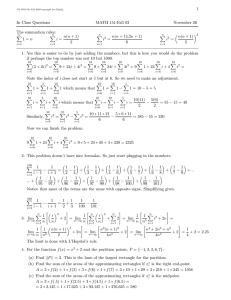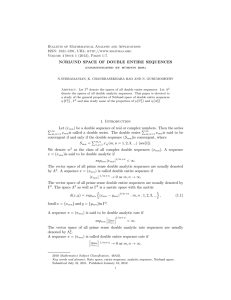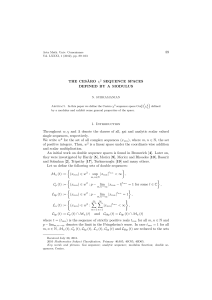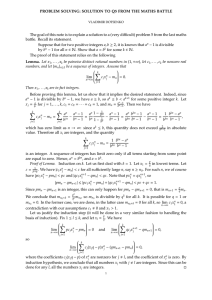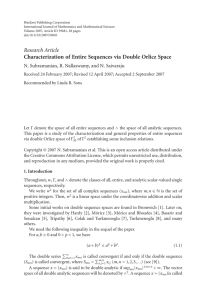THE CES ` ARO χ SEQUENCE SPACES DEFINED BY A MODULUS
advertisement
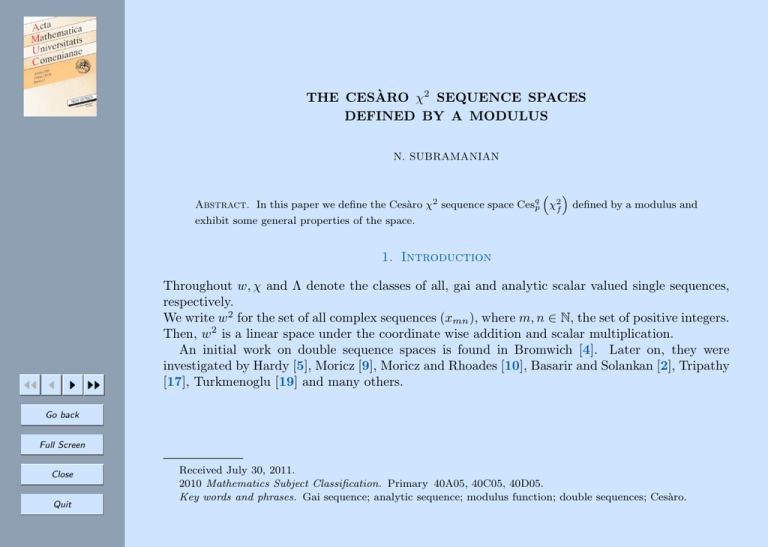
THE CESÀRO χ2 SEQUENCE SPACES
DEFINED BY A MODULUS
N. SUBRAMANIAN
“ ”
Abstract. In this paper we define the Cesàro χ2 sequence space Cesqp χ2f defined by a modulus and
exhibit some general properties of the space.
1. Introduction
JJ J
I II
Throughout w, χ and Λ denote the classes of all, gai and analytic scalar valued single sequences,
respectively.
We write w2 for the set of all complex sequences (xmn ), where m, n ∈ N, the set of positive integers.
Then, w2 is a linear space under the coordinate wise addition and scalar multiplication.
An initial work on double sequence spaces is found in Bromwich [4]. Later on, they were
investigated by Hardy [5], Moricz [9], Moricz and Rhoades [10], Basarir and Solankan [2], Tripathy
[17], Turkmenoglu [19] and many others.
Go back
Full Screen
Close
Quit
Received July 30, 2011.
2010 Mathematics Subject Classification. Primary 40A05, 40C05, 40D05.
Key words and phrases. Gai sequence; analytic sequence; modulus function; double sequences; Cesàro.
Let us define the following sets of double sequences:
tmn
2
<∞ ,
Mu (t) := (xmn ) ∈ w : sup |xmn |
m,n∈N
Cp (t) :=
2
(xmn ) ∈ w : p −
lim |xmn − l|
m,n→∞
t
tmn
= 1 for some l ∈ C ,
=1 ,
)
(xmn ) ∈ w2 : p − lim |xmn | mn
m,n→∞
(
∞ X
∞
X
t
Lu (t) := (xmn ) ∈ w2 :
|xmn | mn < ∞ ,
C0p (t) :=
m=1 n=1
Cbp (t) := Cp (t) ∩ Mu (t)
JJ J
I II
Go back
Full Screen
Close
Quit
and C0bp (t) = C0p (t) ∩ Mu (t)
where t = (tmn ) is the sequence of strictly positive reals tmn for all m, n ∈ N and p − limm,n→∞
denotes the limit in the Pringsheim’s sense. In case tmn = 1 for all m, n ∈ N, Mu (t), Cp (t), C0p (t),
Lu (t), Cbp (t) and C0bp (t) are reduced to the sets Mu , Cp , C0p , Lu , Cbp and C0bp , respectively.
Now, we may summarize the knowledge given in some documents related to the double sequence
spaces. Gökhan and Colak [21, 22] proved that Mu (t) and Cp (t), Cbp (t) are complete paranormed
spaces of double sequences and gave the α-, β-, γ- duals of the spaces Mu (t) and Cbp (t). Quite
recently, Zelter [23] in her PhD thesis, essentially studied both the theory of topological double
sequence spaces and the theory of summability of double sequences. Mursaleen and Edely [24]
recently introduced the statistical convergence and Cauchy for double sequences and gave the
relation between statistical convergent and strongly Cesàro summable double sequences. Next,
Mursaleen [25] and Mursaleen and Edely [26] defined the almost strong regularity of matrices
for double sequences and applied these matrices to establish a core theorem and introduced the
M -core for double sequences and determined those four dimensional matrices transforming every
JJ J
I II
bounded double sequence x = (xjk ) into one whose core is a subset of the M -core of x. More
recently, Altay and Basar [27] defined the spaces BS, BS (t), CS p , CS bp , CS r and BV of double
sequences consisting of all double series whose sequence of partial sums are in the spaces Mu ,
Mu (t), Cp , Cbp , Cr and Lu , respectively, and also examined some properties of those sequence
spaces and determined the α-duals of the spaces BS, BV, CS bp and the β (ϑ) − duals of the spaces
CS bp and CS r of double series. Further Basar and Sever [28] introduced the Banach space Lq
of double sequences corresponding to the well-known space `q of single sequences and examined
some properties of the space Lq . Quite recently Subramanian and Misra [29] studied the space
χ2M (p, q, u) of double sequences and gave some inclusion relations.
Spaces that are strongly summable sequences were discussed by Kuttner [31], Maddox [32], and
others. The class of sequences which are strongly Cesàro summable with respect to a modulus
was introduced by Maddox [8] as an extension of the definition of strongly Cesàro summable
sequences. Connor [33] further extended this definition to a definition of strong A-summability
with respect to a modulus where A = (an,k ) is a nonnegative regular matrix and established some
connections among strong A-summability, strong A-summability with respect to a modulus, and
A-statistical convergence. In [34] the notion of convergence of double sequences was presented by
A. Pringsheim. Also, in [35]–[38] and [39] the four dimensional matrix transformation (Ax)k,` =
P∞ P∞ mn
m=1
n=1 ak` xmn was studied extensively by Robison and Hamilton. This will be accomplished
by presenting the following sequence spaces:
Go back
Cesqp χ2f = d (x, 0)
1
!pmnpmn
j
i
∞
∞
XX 1 X X
1
2
m+n
=0
= x∈χ := lim
qmn f ((m + n) |xmn |)
m,n→∞
Qij m=1 n=1
i=1 j=1
Full Screen
Close
Quit
and
Cesqp Λ2f = d (x, 0)
∞ X
∞
X
= x ∈ χ2 := sup
i=1 j=1
j
i
1
1 XX
qmn f (|xmn |) m+n
Qij m=1 n=1
1
!pmn pmn
<∞
where f is a modulus function. Other implications, general properties and variations will also be
presented.
In the sequel of the paper we need the following inequality
(a + b)p ≤ ap + bp
P∞
for a, b, ≥ 0 and 0 < p < 1. The double series m,n=1 xmn is called convergent if and only if the
Pm,n
double sequence (smn ) is convergent, where smn = i,j=1 xij (m, n ∈ N) (see [1]).
(1.1)
1/m+n
A sequence x = (xmn ) is said to be double analytic if supmn |xmn |
< ∞. The vector space
of all double analytic sequences will be denoted by Λ2 . A sequence x = (xmn ) is called double gai se1/m+n
quence if ((m + n)! |xmn |)
→ 0 as m, n → ∞. The double gai sequences will be denoted by χ2 .
Let
φ
=
{all finite
sequences}.
Consider a double sequence x = (xij ). The (m, n)th section x[m,n] of the sequence is defined by
P m,n
[m,n]
x
=
i,j=0 xij =ij for all m, n ∈ N ; where =ij denotes the double sequence whose only non
JJ J
I II
Go back
Full Screen
Close
Quit
th
1
in the (i, j) place for each i, j ∈ N.
zero term is a (i+j)!
An FK-space (or a metric space) X is said to have AK property if (=mn ) is a Schauder basis
for X. Or equivalently x[m,n] → x.
An FDK-space is a double sequence space endowed with a complete metrizable; locally convex
topology under which the coordinate mappings x = (xk ) → (xmn ) (m, n ∈ N)
are also continuous.
Orlicz [13] used the idea of Orlicz function to construct the space LM . Lindenstrauss and
Tzafriri [7] investigated Orlicz sequence spaces in more detail and proved that every Orlicz sequence
space `M contains a subspace isomorphic to `p (1 ≤ p < ∞). Subsequently, different classes of
sequence spaces were defined by Parashar and Choudhary [14], Mursaleen et al. [11], Bektas and
Altin [3], Tripathy et al. [18], Rao and Subramanian [15] and many others. The Orlicz sequence
spaces are the special cases of Orlicz spaces studied in [6].
Recalling [13] and [6], an Orlicz function is a function M : [0, ∞) → [0, ∞) which is continuous,
non-decreasing and convex with M (0) = 0, M (x) > 0 for x > 0 and M (x) → ∞ as x → ∞.
If convexity of Orlicz function M is replaced by subadditivity of M , then this function is called
modulus function, defined by Nakano [12] and further discussed by Ruckle [16] and Maddox [8],
and many others.
An Orlicz function M is said to satisfy the ∆2 -condition for all values of u if there exists a
constant K > 0 such that M (2u) ≤ KM (u) (u ≥ 0). The ∆2 -condition is equivalent to M (`u) ≤
K`M (u) for all values of u and for ` > 1.
Lindenstrauss and Tzafriri [7] used the idea of Orlicz function to construct Orlicz sequence
space
(
)
∞
X
|xk |
`M = x ∈ w :
M
< ∞, for some ρ > 0 .
ρ
k=1
The space `M with the norm
JJ J
I II
(
kxk = inf
Go back
Full Screen
Close
k=1
M
|xk |
ρ
)
≤1
becomes a Banach space which is called an Orlicz sequence space. For M (t) = tp , (1 ≤ p < ∞),
the spaces `M coincide with the classical sequence space `p .
If X is a sequence space, we give the following definitions:
0
Quit
ρ>0:
∞
X
(i) X is the continuous dual of X;
(
(ii) X α =
a = (amn ) :
∞
P
)
|amn xmn | < ∞, for each x ∈ X ;
m,n=1
(
β
∞
P
)
amn xmn is convergent, for each x ∈ X ;
(
)
M,N
P
γ
(iv) X = a = (amn ) : sup ≥ 1, a x < ∞, for each x ∈ X ;
m,n=1 mn mn mn
n
o
0
(v) let X be an FK-space ⊃ φ; then X f = f (=mn ) : f ∈ X ;
1/m+n
δ
(vi) X = a = (amn ) : sup |amn xmn |
< ∞, for each x ∈ X ;
(iii) X =
a = (amn ) :
m,n=1
mn
X α , X β , X γ are called α- (or Köthe-Toeplitz)-dual of X, β- (or generalized- Köthe-Toeplitz)-dual
of X, γ-dual of X, δ-dual of X, respectively. X α was defined by Gupta and Kamptan [20]. It
is clear that xα ⊂ X β and X α ⊂ X γ , but X β ⊂ X γ does not hold, since the sequence of partial
sums of a double convergent series need not to be bounded.
The notion of difference sequence spaces (for single sequences) was introduced by Kizmaz [30]
as follows
JJ J
I II
Go back
Full Screen
Close
Quit
Z (∆) = {x = (xk ) ∈ w : (∆xk ) ∈ Z}
for Z = c, c0 and `∞ , where ∆xk = xk − xk+1 for all k ∈ N.
Here c, c0 and `∞ denote the classes of convergent, null and bounded scalar valued single sequences, respectively. The difference space bvp of the classical space `p was introduced and studied
in the case 1 ≤ p ≤ ∞ by Basar and Altay in [42] and in the case 0 < p < 1 by Altay and Basar
in [43]. The spaces c (∆), c0 (∆), `∞ (∆) and bvp are Banach spaces normed by
kxk = |x1 | + sup |∆xk |
k≥1
and
kxkbvp =
∞
X
!1/p
p
|xk |
, (1 ≤ p < ∞) .
k=1
Later on the notion was further investigated by many others. We now introduce the following
difference double sequence spaces defined by
Z (∆) = x = (xmn ) ∈ w2 : (∆xmn ) ∈ Z
where Z = Λ2 , χ2 and ∆xmn = (xmn − xmn+1 ) − (xm+1n − xm+1n+1 ) = xmn − xmn+1 − xm+1n +
xm+1n+1 for all m, n ∈ N.
2. Definitions and Preliminaries
Cesqp χ2f and Cesqp Λ2f denote the Pringscheims sense of Cesàro double gai sequence space of
modulus and Pringscheims sense of Cesàro double analytic sequence space of modulus, respecctively.
JJ J
I II
Go back
Full Screen
Close
Quit
Definition 2.1. A modulus function was introduced by Nakano [12]. We recall that a modulus
f is a function from [0, ∞) → [0, ∞) such that
(1)
(2)
(3)
(4)
f (x) = 0 if and only if x = 0,
f (x + y) ≤ f (x) + f (y) for all x ≥ 0, y ≥ 0,
f is increasing,
f is continuous from the right at 0. Since |f (x) − f (y)| ≤ f (|x − y|), it follows from here
that f is continuous on [0, ∞).
Definition 2.2. Let A = amn
denote a four dimensional summability method that maps
k,`
the complex double sequences x into the double sequence Ax where the k, `-th term to Ax is as
follows:
∞
∞ X
X
amn
(Ax)k` =
k` xmn .
m=1 n=1
Such transformation is said to be nonnegative if amn
k` is nonnegative.
The notion of regularity for two dimensional matrix transformations was presented by Silverman
[40] and Toeplitz [41]. Following Silverman and Toeplitz, Robison and Hamilton presented the
following four dimensional analog of regularity for double sequences in which they both added an
adiditional assumption of boundedness. This assumption was made because a double sequence
which is P -convergent is not necessarily bounded.
Definition 2.3. Let p ∈ [1, ∞) and q be a double gai sequence of positive real numbers such
that
j
i X
X
Qij =
qmn ,
i, j ∈ N,
m=0 n=0
JJ J
I II
Go back
Full Screen
Close
Quit
Cesqp
χ2f
= d (x, 0)
1
!pmnpmn
j
i
∞
∞
XX 1 X X
1
2
m+n
qmn f ((m + n) |xmn |)
=0
= x∈χ := lim
m,n→∞
Qij m=1 n=1
i=1 j=1
If qmn = 1 for all m, n ∈ N, then Cesqp χ2f reduces to Cesp χ2f , and if f (x) = x, then Cesqp χ2f
reduces to Cesqp χ2 .
Definition 2.4. Let p ∈ [1, ∞) and q be a double analytic sequence of positive real numbers
such that
Qij =
j
i X
X
qmn ,
i, j ∈ N,
m=0 n=0
Cesqp Λ2f = d (x, 0)
∞ X
∞
X
= x ∈ χ2 := sup
i=1 j=1
j
i
1
1 XX
qmn f (|xmn |) m+n
Qij m=1 n=1
1
!pmn pmn
<∞
.
If qmn = 1 for all m, n ∈ N, then Cesqp Λ2f reduces to Cesp Λ2f , and if f (x) = x, then Cesqp Λ2f
reduces to Cesqp Λ2 .
JJ J
I II
The space Cesqp χ2f is a metric space with the metric
Go back
Full Screen
Close
Quit
d (x, y)
1
!pmn pmn
j
∞ X
∞
i X
X
X
1
1
m+n
= inf sup
qmn f ((m + n)! |xmn −ymn |)
≤1
Qij m=1n=1
i=1 j=1
The space Cesqp Λ2f is a metric space with the metric
d (x, y)
∞
∞ X
X
= inf sup
i=1 j=1
j
i
1
1 XX
qmn f (|xmn − ymn |) m+n
Qij m=1 n=1
1
!pmn pmn
≤1 .
3. Main Results
Proposition 3.1. Let x, y ∈ Cesqp χ2f . Then for any ε > 0 and L > 0, there exists δ > 0
pmn
such that (d (x + y, 0) , 0)
pmn
= d (x, 0)
p
pmn
+ ε, whenever d (x, 0) ≤ L and d (y, 0)
≤ δ.
Proof. For any fix ε > 0,
d (x + y, 0)
JJ J
I II
Go back
Full Screen
Close
Quit
pmn
!p
j
i
mn
1
1 XX
=
qmn f ((m + n)! |xmn + ymn |) m+n
Q
ij
m=1 n=1
i=1 j=1
!p
j
∞
∞
i
mn
XX
1
1 XX
m+n
≤
qmn f ((m + n)! |xmn |)
Qij m=1 n=1
i=1 j=1
!p
j
∞ X
∞
i
mn
X
1
1 XX
+
qmn f ((m + n)! |ymn |) m+n
Qij m=1 n=1
i=1 j=1
∞ X
∞
X
!p
j
i
mn
1
1 XX
qmn f ((m + n)! |xmn |) m+n
≤ (1 − β)
Q
ij
m=1 n=1
i=1 j=1
!p
j
∞
∞
i
mn
XX
1
1 XX
m+n
+ (β)
qmn f ((m + n)! |xmn |)
Qij m=1 n=1
i=1 j=1
pmn
1
m+n
j q
i X
∞ X
∞
X
X
mn f ((m + n)! |ymn |)
1
· (β)
Q
β
ij
m=1 n=1
i=1 j=1
!p
j
∞ X
∞
i
mn
X
1
1 XX
≤
qmn f ((m + n)! |xmn |) m+n
Q
ij
m=1 n=1
i=1 j=1
!p
j
∞
∞
i
mn
1
1 XX
β XX
m+n
2qmn f ((m + n)! |xmn |)
+
2 i=1 j=1 Qij m=1 n=1
pmn
1
m+n
j
∞ ∞
i
β X X 1 X X 2qmn f ((m + n)! |ymn |)
·
2 i=1 j=1 Qij m=1 n=1
β
∞ X
∞
X
JJ J
I II
Go back
Full Screen
+
Close
Quit
ε
2
pmn −1 X
∞ X
∞
2
pmn
≤ d (x, 0)
β
+
i=1 j=1
pmn
≤ d (x, 0)
pmn
≤d (x, 0)
ε ε
+ +
2 2
+ ε.
j
i
1
1 XX
qmn f ((m + n)! |ymn |) m+n
Qij m=1 n=1
!pmn
Proposition 3.2. For every p = (pmn ),
β α γ β
Cesqp Λ2f
= Cesqp Λ2f
= Cesqp Λ2f
= Cesqp ηf2
,
where
Cesqp ηf2
∞ X
∞
\
X
=
x = xmn :
N ∈N−{1}
JJ J
I II
Go back
Full Screen
Close
Quit
i=1 j=1
j
i
m+n
1 XX
qmn f |xmn | N pmn
Qij m=1 n=1
1
! pmn
<∞
.
h
i h
iβ
Proof. First we show that Cesqp ηf2 ⊂ Cesqp Λ2f
.
h
i
h
iβ
Let x ∈ Cesqp ηf2 and y ∈ Cesqp Λ2f
. Then we can find a positive integer N such that
1/m+n
|ymn |
! 1
j
i X
∞ X
∞
pmn pmn
X
X
1
1
<N
qmn f |ymn | m+n
< max 1, sup
Qij m=1 n=1
m,n≥1 i=1 j=1
for all m, n.
Hence we may write
X
X
X
X
xmn ymn ≤
|xmn ymn | ≤
(f (|xmn ymn |)) ≤
f |xmn | N m+n .
m,n
m,n
mn
m,n
Since x ∈ Cesqp ηf2 . The series on the right side of the above inequality is convergent, whence
h
i h
iβ
x ∈ Cesqp Λ2f . Hence Cesqp ηf2 ⊂ Cesqp Λ2f
.
h
iβ h
i
Now we show that Cesqp Λ2f
⊂ Cesqp ηf2 .
h
iβ
h
i
For this, let x ∈ Cesqp Λ2f
and suppose that x ∈
/ Cesqp Λ2f . Then there exists a positive
P
integer N > 1 such that m,n (f (|xmn | N m+n )) = ∞.
h
i
If we define ymn = N m+n Sgnxmn m, n = 1, 2, · · · , then y ∈ Cesqp Λ2f .
But, since
X
X
X
xmn ymn =
f |xmn | N m+n = ∞,
(f (|xmn ymn |)) =
m,n
mn
m,n
h
iβ
h
iβ
we get x ∈
/ Cesqp Λ2f
, which contradicts the assumption x ∈ Cesqp Λ2f
. Therefore x ∈
h
i
h
iβ h
i
Cesqp ηf2 and Cesqp Λ2f
= Cesqp ηf2 .
(ii)and (iii) can be shown in a similar way of (i). Therefore, we omit it.
JJ J
I II
Go back
Proposition 3.3. Let p = (pmn ) be a Cesàro space of double analytic modulus sequence of
strictly positive real numbers pmn . Then
(i) Cesqp Λ2f is a paranormed space with
Full Screen
Close
Quit
(3.1)
∞ X
∞
X
g (x) = sup
i=1 j=1
1
pmn
! pmn
M
j
i X
X
1
1
qmn f |xmn | m+n
Qij m=1 n=1
if and only
if h = inf pmn > 0, where M = max (1, H) and H = sup pmn .
(ii) Cesqp Λ2f is a complete paranormed linear metric space if the condition p in (3.1) is
satisfied.
Proof. The proof of (i). Sufficiency. Let h > 0. It is trivial that g (θ) = 0 and g (−x) = g (x).
The inequality g (x + y) ≤ g (x) + g (y) follows from the inequality
(3.1),
since pmn /M ≤ 1
h/M
p
g (x), since |λ| mn ≤
for all positive integers m, n. We also may write g (λx) ≤ max |λ| , |λ|
h
M
for all positive integers m, n and for any λ ∈ C, the set of complex numbers.
max |λ| , |λ|
Using this inequality, it can be proved that λx → θ, when x is fixed and λ → 0, or λ → 0 and
x → θ, or λ is fixed and x → θ.
Necessity. Let Cesqp Λ2f be a paranormed space with the paranorm
g (x) = sup
JJ J
1
pmn
! pmn
M
j
i X
X
1
1
qmn f |xmn | m+n
Qij m=1 n=1
∞ X
∞
X
i=1 j=1
I II
pmn /M
Go back
and suppose that h = 0. Since |λ|
that 0 < |λ| ≤ 1, we have
h/M
≤ |λ|
= 1 for all positive integers m, n and λ ∈ C such
Full Screen
Close
Quit
sup
∞ X
∞
X
i=1 j=1
j
i
1 XX
qmn f (|λ|)
Qij m=1 n=1
1
pmn
! pmn
M
= 1.
Hence it follows that
∞
∞ X
X
g (λx) = sup
i=1 j=1
1
pmn
! pmn
M
j
i X
X
1
=1
qmn f (|λ|)
Qij m=1 n=1
for x = (α) ∈ Cesqp Λ2f as λ → 0. But this contradicts the assumption Cesqp Λ2f is a paranormed
space with g (x) .
The proof of (ii) is clear.
Corollary 3.4. Cesqp Λ2f is a complete paranormed space with the natural paranorm if and
only if Cesqp Λ2f = Cesq Λ2f .
h
iβ
Proposition 3.5. For every p = (pmn ) , Cesqp ηf2 ⊂ Cesqp χ2f
& Cesqp Λ2f .
JJ J
I II
Go back
Full Screen
h
iβ
. We know that
Proof. The proof of (i). First, we show that Cesqp ηf2 ⊂ Cesqp χ2f
h
i
Cesqp χ2f ⊂ Cesqp Λ2f .
iβ
iβ
h
iβ h
h
Cesqp Λ2f
⊂ Cesqp χ2f
. But Cesqp Λ2f
= Cesqp ηf2 by Proposition 3.2. Therefore,
β
Cesqp ηf2 ⊂ Cesqp χ2f
.
h
iβ
The proof of (ii). Now we show that Cesqp χ2f
& Cesqp Λ2f .
(3.2)
Close
Quit
iβ
h
. If y is not Cesqp Λ2f , then for each natural
Let y = (ymn ) be an arbitrary point Cesqp χ2f
number q, we can find an index mp nq such that
1
!pmn pmn
j
∞
∞ X
i X
X
X
m 1+n 1
>q
qmq nq f (mq + nq )! ymq nq q q
Q
ij
m=1 n=1
i=1 j=1
for (1, 2, 3, · · · ). Define x = {xmn } by
!
j
∞ X
∞
i X
X
X
1
1
1
p
qmn f (((m + n)! |xmn |) mn ) pmn > q m+n
Q
ij m=1 n=1
i=1 j=1
for (mn) = (mq nq ) and some q ∈ N; and
!
j
i X
∞ X
∞
X
X
1
1
p
qmn f (((m + n)! |xmn |) mn ) pmn = 0, otherwise.
Q
ij
m=1 n=1
i=1 j=1
JJ J
I II
Then x is Cesqp χ2f , but for infinitely mn,
Go back
Full Screen
Close
Quit
(3.3)
∞ X
∞
X
i=1 j=1
j
i
1
1 XX
p
qmn f (((m + n)! |ymn xmn |) mn ) pmn
Qij m=1 n=1
!
> 1.
Consider the sequence z = {zmn } , where
Q11 (q11 f (2!z11 )
pmn pmn
)
pmn pmn
= Q11 (q11 f (2!x11 )
)
−s
with
∞
∞ X
X
s=
i=1 j=1
∞ X
∞
X
i=1 j=1
j
i
1
1 XX
p
qmn f (((m + n)! |xmn |) mn ) pmn
Qij m=1 n=1
j
i
1
1 XX
p
qmn f (((m + n)! |zmn |) mn ) pmn
Qij m=1 n=1
∞ X
∞
X
=
i=1 j=1
!
;
!
j
i
1
1 XX
p
qmn f (((m + n)! |xmn |) mn ) pmn
Qij m=1 n=1
!
.
The z is a point of Cesqp χ2f . Also
!
j
∞ X
∞
i X
X
X
1
1
p
qmn f (((m + n)! |zmn |) mn ) pmn = 0.
Q
ij
m=1 n=1
i=1 j=1
JJ J
I II
Go back
Full Screen
Close
Quit
Hence z is in Cesqp χ2f . But, by the equation (3.3),
!
j
∞ X
∞
i X
X
X
1
1
p
qmn f (((m + n)! |zmn ymn |) mn ) pmn
Q
ij m=1 n=1
i=1 j=1
h
iβ
PP
does not converge and so
xmn ymn diverges. Thus, the sequence y would not be Cesqp χ2f
.
This contradiction proves that
(3.4)
Cesqp χ2f
β
⊂ Cesqp Λ2f .
If we now choose f = id, where id is the identity and
1
1
(q1n ((m + n)!y1n )) =
(q1n ((m + n)!x1n ))
Q1j
Q1j
and
1
1
(qmn ((m + n)!ymn )) =
(qmn ((m + n)!xmn )) = 0,
Qij
Qij
for all n, j, then obviously x ∈ Cesqp χ2f and y ∈ Cesqp Λ2f , but
XX
(3.5)
xmn ymn = ∞.
(m, i > 1)
h
iβ
Hence y ∈
/ Cesqp χ2f
.
h
iβ
From (3.4) and (3.5), we are granted Cesqp χ2f
& Cesqp Λ2f .
JJ J
I II
Proposition 3.6. In Cesqp χ2f weak convergence does not imply strong convergence.
Go back
Full Screen
Close
Quit
Proof. Assume that weak convergence implies strong convergence Cesqp χ2f . Then, we would
h
iββ
have Cesqp χ2f
= Cesqp χ2f [see Wilansky]. But
ββ β
Cesqp χ2f
& Cesqp Λ2f
= Cesqp ηf2 .
iββ
h
6= Cesqp χ2f . Hence weak convergence does not imply strong convergence in
Thus Cesqp χ2f
Cesqp χ2f .
Proposition 3.7. Let f be an modulus function which satisfies the ∆2 -condition.
Cesqp χ2 ⊂ Cesqp χ2f .
Proof. Let
x ∈ Cesqp χ2 .
(3.6)
Then
∞ X
∞
X
i=1 j=1
JJ J
I II
Go back
Full Screen
Close
Quit
j
i
1
1 XX
p
qmn (((m + n)! |xmn |) mn ) pmn
Qij m=1 n=1
!
≤ε
for sufficiently large m, n and every ε > 0.
!
j
∞ X
∞
i X
X
X
1
1
p
qmn f (((m + n)! |xmn |) mn ) pmn ≤ f (ε)
Q
ij
m=1 n=1
i=1 j=1
(because f is non-decreasing). This implies
!
j
∞ X
∞
i X
X
X
1
1
p
qmn f (((m + n)! |xmn |) mn ) pmn ≤ Kf (ε) < (ε)
Q
ij m=1 n=1
i=1 j=1
Then
ε
(by the ∆2 -condition, for some K > 0 and by defining f (ε) < K
).
!p 1
j
∞
∞ X
i X
mn pmn
X
X
1
1
= 0.
lim
qmn f ((m + n)! |xmn |) m+n
(3.7)
m,n→∞
Q
ij
m=1n=1
i=1 j=1
Hence
(3.8)
From (3.6) and (3.8), we get Cesqp
x ∈ Cesqp χ2f .
χ2 ⊂ Cesqp χ2f .
h
iβ
Proposition 3.8. Cesqp Λ2f
& Cesqp χ2f .
JJ J
I II
Go back
Full Screen
Close
Quit
h
iβ
Proof. Let (xmn ) ∈ Cesqp Λ2f
XX
(3.9)
|xmn ymn | < ∞
h
iβ
for all (ymn ) ∈ Cesqp Λ2f
. Assume that (xmn ) ∈
/ Cesqp χ2f . Then there exists a sequence of
positive integers
1
,
f (|xmr +nr |) > (r = 1, 2, 3, · · · ) .
(m +n )
(mr + nr !2) r r
Take
ymr +nr =
(2 (mr + nr )!)mr +nr
for r = 1, 2, 3, · · · ,
y
mr +nr = 0
otherwise.
i
h
Then (ymn ) ∈ Cesqp Λ2f . But
XX
|xmn ymn | =
∞
X
|xmr +nr ymr +nr | = f
r=1
∞
X
!
|xmr +nr ymr +nr |
r=1
> 1 + 1 + 1 + ··· .
We know that the infinite series 1 +1 +1 + . . . diverges. Hence
contradicts (3.9). Hence (xmn ) ∈ Cesqp χ2f . Therefore,
PP
|xmn ymn | diverges. This
β
Cesqp Λ2f
⊂ Cesqp χ2f .
(3.10)
If we now choose p = (pmn ), it is a constant f = id, where id is the identity and
1
(q1n ((1 + n)!y1n )) =
Q1j
1
(qmn ((m + n)!ymn )) =
Qij
JJ J
I II
Go back
Full Screen
Close
Quit
1
(q1n ((1 + n)!x1n ))
and
Q1j
1
(qmn ((m + n)!xmn )) = 0
Qij
where (m, i > 1) for all n, j, then obviously x ∈ Cesqp χ2f and y ∈ Cesqp Λ2f , but
(3.11)
XX
xmn ymn = ∞.
h
iβ
Hence y ∈
/ Cesqp χ2f
.
h
iβ
From (3.10) and (3.1), we are granted Cesqp Λ2f
& Cesqp χ2f .
∗
∗
denote the dual space of Cesqp χ2f . Then we have Cesqp χ2f
Proposition 3.9. Let Cesqp χ2f
Cesqp Λ2f .
Proof. We recall that
x = =mn
with
JJ J
I II
1
(m+n)!
in the (m, n)
Close
Quit
0,
..
.
=
0,
0,
0,
0,
0, . . .
0, . . .
1
(m+n)! ,
0, . . .
0, . . .
0,
0
0
0
0
position and zero otherwise, with
1
!pmn pmn
1
1
m+n
qmn f ((m + n)! |xmn |)
Qij m=1 n=1
0, 0, . . .
0,
0, . . . 0
0, . . .
0,
0, . . . 0
0, 0, . . .
0,
0, . . . 0
.
=.
.
(m+n)!
0, . . . (m+n)! , 0, . . . 0
0, 0, . . . 11/m+n , 0, . . . 0
0, . . .
0,
0, . . . 0
0, 0, . . .
0,
0, . . . 0
∞ X
∞
X
x = =mn
i=1 j=1
Go back
Full Screen
th
0, 0, . . .
0, 0, . . .
.
= ..
0, 0, . . .
0, 0, . . .
i
X
j
X
P∞ P∞
which is a Cesqp χ2f sequence. Hence =mn ∈ Cesqp χ2f . Let us take f (x) = m=1 n=1 xmn ymn
∗
. Take x = (xmn ) = =mn ∈ Cesqp χ2f . Then
with x ∈ Cesqp χ2f and f ∈ Cesqp χ2f
|ymn | ≤ kf k d (=mn , 0) < ∞
for each m, n.
Thus (ymn ) is a bounded
double
sequence of modulus. In
sequence andhencean Cesàro
analytic
∗
q
q
q
2
2
2
other words y ∈ Cesp Λf . Therefore Cesp χf
= Cesp Λf .
JJ J
I II
Go back
Full Screen
Close
Quit
1. Apostol T., Mathematical Analysis. Addison-wesley, London, 1978.
2. Basarir M. and Solancan O., On some double sequence spaces. J. Indian Acad. Math. 21(2) (1999), 193–200.
3. Bektas C. and Altin Y., The sequence space `M (p, q, s) on seminormed spaces. Indian J. Pure Appl. Math.
34(4) (2003), 529–534.
4. Bromwich T. J., An introduction to the theory of infinite series. Macmillan and Co.Ltd., New York, 1965.
5. Hardy G. H., On the convergence of certain multiple series, Proc. Camb. Phil. Soc. 19 (1917), 86–95.
6. Krasnoselskii M. A. and Rutickii Y. B., Convex functions and Orlicz spaces. Gorningen, Netherlands 1961.
7. Lindenstrauss J. and Tzafriri L., On Orlicz sequence spaces. Israel J. Math. 10 (1971), 379–390.
8. Maddox I.J., Sequence spaces defined by a modulus. Math. Proc. Cambridge Philos. Soc 100(1) (1986), 161–166.
9. Moricz F., Extentions of the spaces c and c0 from single to double sequences. Acta. Math. Hung. 57(1–2)
(1991), 129–136.
10. Moricz F. and Rhoades B. E., Almost convergence of double sequences and strong regularity of summability
matrices. Math. Proc. Camb. Phil. Soc. 104 (1988), 283-294.
11. Mursaleen M.,Khan M. A. and Qamaruddin, Difference sequence spaces defined by Orlicz functions. Demonstratio Math. XXXII (1999), 145–150.
12. Nakano H., Concave modulars. J. Math. Soc. Japan 5 (1953), 29–49.
13. Orlicz W., Über Raume (LM ), Bull. Int. Acad. Polon. Sci. A (1936), 93–107.
14. Parashar S. D. and Choudhary B., Sequence spaces defined by Orlicz functions. Indian J. Pure Appl. Math.
25(4) (1994), 419–428.
JJ J
I II
Go back
Full Screen
Close
Quit
15. Chandrasekhara Rao K. and Subramanian N., The Orlicz space of entire sequences. Int. J. Math. Math. Sci.
68 (2004), 3755–3764.
16. Ruckle W. H., FK spaces in which the sequence of coordinate vectors is bounded. Canad. J. Math. 25 (1973),
973–978.
17. Tripathy B. C., On statistically convergent double sequences. Tamkang J. Math. 34(3), (2003), 231–237.
18. Tripathy B. C., Et M. and Altin Y., Generalized difference sequence spaces defined by Orlicz function in a
locally convex space. J. Anal. Appl., 1(3) (2003), 175–192.
19. Turkmenoglu A., Matrix transformation between some classes of double sequences. J. Inst. Math. Comp. Sci.
Math. Ser. 12(1) (1999), 23–31.
20. Kamthan P. K. and Gupta M., Sequence spaces and series. Lecture notes, Pure and Applied Mathematics 65.
Marcel Dekker, In c., New York, 1981.
P B (p). Appl. Math. Comput. 157(2) (2004),
21. Gökhan A. and Çolak R., The double sequence spaces cP
2 (p) and c2
491–501.
22.
, Double sequence spaces `∞
2 . Appl. Math. Comput.160(1) (2005), 147–153.
23. Zeltser M., Investigation of Double Sequence Spaces by Soft and Hard Analitical Methods. Dissertationes Mathematicae Universitatis Tartuensis 25, Tartu University Press, Univ. of Tartu, Faculty of Mathematics and
Computer Science, Tartu, 2001.
24. Mursaleen M. and Edely O. H. H., Statistical convergence of double sequences. J. Math. Anal. Appl. 288(1)
(2003), 223–231.
, Almost convergence and a core theorem for double sequences. J. Math. Anal. Appl. 293(2) (2004),
25.
532–540.
26. Mursaleen M., Almost strongly regular matrices and a core theorem for double sequences. J. Math. Anal. Appl.
293(2) (2004), 523–531.
27. Altay B. and Başar F., Some new spaces of double sequences. J. Math. Anal. Appl. 309(1) (2005), 70–90.
28. Başar F. and Sever Y., The space Lp of double sequences. Math. J. Okayama Univ 51 (2009), 149–157.
29. Subramanian N. and Misra U. K., The semi normed space defined by a double gai sequence of modulus function.
Fasciculi Math. 46 (2010).
30. Kizmaz H., On certain sequence spaces. Cand. Math. Bull. 24(2) (1981), 169–176.
31. Kuttner B., Note on strong summability. J. London Math. Soc. 21 (1946), 118–122.
32. Maddox I. J., On strong almost convergence. Math. Proc. Cambridge Philos. Soc. 85(2) (1979), 345–350.
33. Cannor J., On strong matrix summability with respect to a modulus and statistical convergence. Canad. Math.
Bull. 32(2) (1989), 194–198.
34. Pringsheim A., Zurtheorie derzweifach unendlichen zahlenfolgen. Math. Ann. 53 (1900), 289–321.
35. Hamilton H. J., Transformations of multiple sequences. Duke Math. J. 2 (1936), 29–60.
36.
, A Generalization of multiple sequences transformation. Duke Math. J. 4 (1938), 343–358.
, Change of Dimension in sequence transformation. Duke Math. J. 4 (1938), 341–342.
37.
38.
, Preservation of partial Limits in Multiple sequence transformations. Duke Math. J. 4 (1939), 293–297.
39. Robison G. M., Divergent double sequences and series. Amer. Math. Soc. Trans. 28 (1926), 50–73.
40. Silverman L. L., On the definition of the sum of a divergent series. Unpublished thesis, University of Missouri
studies, Mathematics series.
41. Toeplitz O., Über allgenmeine linear mittel bridungen. Prace Matemalyczno Fizyczne 22 (1911).
42. Başar F. and Atlay B., On the space of sequences of p-bounded variation and related matrix mappings. Ukrainian
Math. J. 55(1) (2003), 136–147.
43. Altay B. and Başar F., The fine spectrum and the matrix domain of the difference operator ∆ on the sequence
space `p , (0 < p < 1). Commun. Math. Anal. 2(2) (2007), 1–11.
44. Çolak R., Et M. and Malkowsky E., Some Topics of Sequence Spaces, Lecture Notes in Mathematics. Firat
Univ. Elazig, 2004, 1–63.
N. Subramanian, Department of Mathematics, SASTRA University, Thanjavur-613 401, India,
e-mail: nsmaths@yahoo.com
JJ J
I II
Go back
Full Screen
Close
Quit
